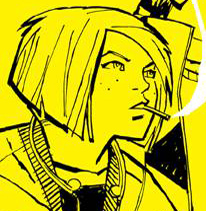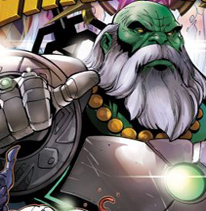Deadshirt Is Reading… is a weekly feature in which Deadshirt’s staff, contributing writers, and friends-of-the-site offer their thoughts on Big Two cape titles, creator-owned books, webcomics and more. For more of our thoughts on this week’s new comics, take a look at Wednesday’s Deadshirt Comics Shopping List.
Kayleigh Hearn is reading…
Written by Brian K. Vaughan
Art by Cliff Chiang
Colored by Matt Wilson
Lettered by Jared K. Fletcher
Image Comics
“Terrific. Nothing spooky about basements.”
Paper Girls is one of my most anticipated new comics of the year. Brian K. Vaughan’s Runaways is one of my favorite comics in the world, so I was excited to see him writing a cast of young characters again, and Cliff Chiang’s artwork is impeccable and stunning—since it was announced, this was definitely a comic to look out for. Taking place in Cleveland in 1988, Paper Girls features four plucky tween girls (Erin, KJ, Mac, and Tiffany) beginning their paper route the morning after Halloween. It’s clear early on that the girls are about to have a stressful morning, as they encounter shitty teen boys in Freddy Kruegger costumes and judgmental police officers on their way. But then the girls make a surprising discovery, and Paper Girls switches from “Lumberjanes with swears” to a different genre entirely.
Paper Girls is a comic filled with atmosphere and character. Chiang’s artwork creates a sense of quiet, suburban menace as Erin rides her bike alone down deserted streets still filled with the flotsom and jetsam of Halloween (a scarecrow here, a tree draped with toilet paper there). Paper Girls can easily be compared to the classic works of Stephen King, with its young cast and a town suddenly caught up in something much bigger and stranger than itself. Though of course they’re not fully fleshed out in this first issue, the girls all have sparkles of personality–the science-y one, the girl from the wrong side of the tracks, etc.—and Chiang’s character designs are sharp and authentic. (I especially like Erin’s big, 80s jean jacket.)
It’s a strong first issue, but for a writer of Brian K. Vaughan’s caliber, it doesn’t feel strong enough. (Remember the cliffhanger in Runaways’ first issue, or the apocalyptic shock of Y: The Last Man #1?) The opening scene in particular, a symbolic, violent dream sequence, felt like a scene that had been scrapped from a draft of Saga rather than something fresh and original to Paper Girls. Considering the strength of Chiang’s artwork and the promising cast of characters, I hope the next issue can pick up momentum. Ultimately, Paper Girls #1 is a comic I wanted to love, but merely liked.
Joe Stando is reading…
Written by Al Ewing
Art by Paco Medina (pencils), Juan Vlasco (inks) and David Curiel (colors), Thomas Labourot and Guru-eFX (colors) (backup)
Lettered by Joe Sabino
Marvel
“I am the machine that kills… I am the Guillotine!”
Contest of Champions is a new ongoing comic series that’s based on a mobile game about the Marvel Universe, and also reportedly a follow-up to Secret Wars, a crossover event that isn’t actually over yet. It’s a convoluted premise that I would consider skipping, if not for the fact that it’s written by Al Ewing, who’s consistently been churning out the best work at Marvel for a while now. So I figured I’d give the book a shot, and it paid off.
Contest of Champions drops you right into the thick of it, with a free-for-all melee between familiar characters like Venom and Gamora and new or obscure ones like Outlaw and a Hydra-allied Moon Boy and Devil Dinosaur. We get glimpses of the people involved in the gladiatorial game, from the Collector (redesigned to look like the movie version) to Maestro, the world-conquering alternate future version of Hulk. It’s mostly teases and setup this issue, which is fine by me.
The nice thing about this book is that it hides how much of it is directed by other influences. With the exception of a couple pages of as material, the game isn’t referenced at all, with space instead being spent on building up new characters like White Fox and Guillotine. Medina and Labourot’s designs are fun and dynamic, and don’t feel beholden to the style of the video game either. Ewing has proven he’s got a good handle on the sort of bombastic ideas that make for fun alternate reality stories, and hopefully this book will continue to prove fertile soil for him and his collaborators. At the very least, it doesn’t feel like an ad.
 Andrew Niemann is reading…
Andrew Niemann is reading…
1602: Witch Hunter Angela #4
Written by Marguerite Bennett and Kieron Gillen
Art by Stephanie Hans and Kody Chamberlain
Colored by Lee Loughridge
Lettered by VC’s Clayton Clowes
Marvel Comics
“Though crowned with horn and flower/So dread to be seen/She is loved by her companion/My lost and Faustian Queen”
1602: Witch Hunter Angela is the long-awaited return to Neil Gaiman’s Renaissance era Marvel Universe, and, boy, what a trip! Yet while Gaiman’s re-interpretation of the universe focused on its more historical and mundane characteristics, Marguerite Bennett’s take dives deep into the world of Faerie, Christian esoterica, and Elizabethan tragedy. Throughout four issues, Angela and her lover/companion Serah hunt down vicious Faustians, pastiches of classic Marvel supervillains interpreted here as demons. They also encounter traditional mutants, called the Witchbreed in this universe, and even meet up with the Guardians of the Galaxy, portrayed here as an eccentric troupe of Shakespearean actors.
In this week’s issue #4, Angela is tasked with defeating the Enchantress, Faustian Queen of the Faerie Realm, in order to end her magical blight upon the world. The plot cleverly mirrors the main story of Angela: Asgard’s Assassin (and leads into the upcoming Angela: Queen of Hel) through exploring the star-crossed relationship between the fiery Angela and the serene Serah. The influence of Shakespeare and Marlowe is present here with scenes of Angela talking to a skull ala Hamlet, and the Enchantress, in peak Oberon form, offering up temptations and deals like the villain of the classic Marlowe play. The backup epilogue, which provides a framework for the tale, even involves the playwrights themselves and notably evokes quite a few issues of Gaiman’s Sandman.
In this series, Bennett deftly plays with Angela’s moral ambiguity (as well as Serah’s) which really suits the world and culture where these characters find themselves. It’s no surprise that Angela, a crossover character from the Spawn comics, is Marvel’s most overtly religious character at present. This makes her a natural fit for this type of storytelling which touches on religious hypocrisy, LGBT relationships, and hard moral choices, all in one package. In turn, the art by Stephanie Hans is particularly stunning. Every panel casts Angela in either cavernous cathedrals or sun-lit forests. The dream-like quality of Angela’s temptations spread out on the page like water and flow quite beautifully. Hans’ captivating art, which blends different styles from Renaissance oil paintings to mosaic cathedral frescoes, makes this book stand out as one of the most gorgeous titles this year. 1602: Witch Hunter Angela is worth the read because of its detail, design, and dedication to its world and characters.
Thanks for reading about what we’re reading! We’ll be back next week with a slew of suggestions from across the comics spectrum. In the meantime, what are you reading? Tell us in the comments section, on Twitter or on our Facebook Page!



